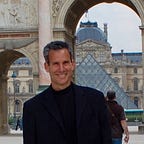All’s Not Fair in Love and War
By Neil Turkewitz
In this polarizing era where facts and nuance are less and less common, it is more important than ever that we celebrate the things that unite us, and that we search for common ground and understanding where it is lacking. I thought it would be interesting, if counter-intuitive given prevailing rhetoric, to examine copyright and fair use with this in mind.
Lost in talk of “copyright wars” and an over-simplified copyright versus tech narrative, is the fact that there is a great deal of common interest and agreement. Indeed, the age of information would be arid (and uninformative) in the absence of either information or modes for distributing and accessing it. Tech and content need each other, are part of each other, and in fact bleed into one another. While there are certainly some outliers and differences related to theories of utilitarianism versus natural rights, at core there is broad agreement on the foundational issues and purposes of copyright law, including the need for a copyright regime that ensures support for working creators and promotes innovation. Most tech companies would agree that copyright protection serves the public interest, and that copyright systems should foster new forms of expression. The creative sector for its part supports the idea that the establishment of modern, robust and effective protection should include appropriate limitations or exceptions to rights, consistent with international treaties and the needs of different cultures (both legal and creative).
Of course, finding appropriate balance in an ever-changing technological universe is, and will be, a constant and evolving challenge, and easy answers will elude us. This is hardly new to copyright or law in general. But engagement in thoughtful and nuanced discussion must not be just one of several options. It should be a requirement.
Copyright protection gives effect to the constitutional goal of promoting the progress of “science” (in the Age of Enlightenment meaning of knowledge) by recognizing and vesting rights in authors. Consistent with this, the Supreme Court held, in its Harper & Row Publishers v. Nation Enterprises (1985) opinion (repeated later in Eldred), that “the Framers intended copyright itself to be the engine of free expression,” based on their understanding that “copyright is intended to increase and not to impede the harvest of knowledge…. The rights conferred by copyright are designed to assure contributors to the store of knowledge a fair return for their labors.”
At the same time, there has been long-standing recognition that certain activities that might technically constitute infringement are of sufficient social value, and of such limited prejudice to the copyright owner, that they should be permitted without the need for obtaining consent from the copyright owner. This is particularly true with respect to news reporting, parody and scholarship. The reason for this is easy to understand: the production of cultural and literary artifacts reflects the past, and may sometimes borrow from earlier expression. As a consequence, all developed copyright laws, and all relevant treaties, provide for circumscribed uses of protected expression without the need for obtaining authorization. This is most famously elaborated in the so-called three part test of Article 9 of the Berne Convention — non-authorized uses may be permitted so long as they: (1) apply only in certain special cases; (2) do not conflict with a normal exploitation of the work; and (3) do not unreasonably prejudice the legitimate interests of the author.
Countries around the world have implemented this authority in a variety of ways — some by providing clear and specific guidelines about permitted uses (this is particularly the case in civil law countries), while others have provided more general frameworks for assessing uses under theories known as fair use (US) or fair dealing (UK and other Commonwealth states). There are benefits and drawbacks to each approach, one emphasizing clarity while the other provides, or may provide, greater flexibility. The important overarching point is that under either approach, it is critical that laws hew to the aforementioned three part test, and countries could fail to do so either through overbroad exceptions, or by judicial decisions giving too expansive a reading of fair use or fair dealing.
This week as people celebrate “Fair Use Week,” it is of vital importance that we properly contextualize fair use. It occupies a place within the copyright world, and exists only as an aspect of defining the scope of control granted to creators under copyright. As such, the celebration of fair use can’t rationally be disentangled from the celebration of copyright. So let’s use this opportunity to cast off the divisive rhetoric, and to celebrate the arts. The arts not only give meaning to life, but fuel the economy. All parties have an interest in sustaining the ability of creators to earn a living from their craft. This is too frequently overlooked in the fight over words and symbols. Our laws should be a constructive tool to encourage creativity, and ensure that artists are able to have the economic stability and flexibility to create. Let’s work together to help all artists, that way we all win. The labels employed to accomplish that are of little relevance; what does matter is that we do it.
Developments in technology have created the potential for a global Renaissance in cultural production and an explosion in the practical ability to engage in fundamental freedoms. But to realize this potential, we need equal parts passion and reason. We must recognize that human dignity and the advancement of societies require forbearance and fairness, the ability to listen as well as the ability to talk. An understanding of our interconnectedness, and an approach to problem solving built on embracing complexity with humility, and the rejection of over-simplified and false dichotomies. I pledge to walk this path, and invite you to join me. For the moment, the path is relatively uncrowded, but I am certain that this too will change.
Dedicated to Bill Patry, my sometimes sparring partner and longtime friend.
